"I hope you blog the hell out of this, for better or for worse," Stephanie told me when she sent me off to the School of Visual Arts Summer Residency program. I'm afraid I disappointed her: I couldn't really blog while the residency was going on. Partly because I was in the studio so much, and partly because, when I wasn't in the studio, if I approached the computer my wife would say, "Didn't we agree you wouldn't approach the computer while you were doing the residency?" We as in she and me agreed to no such thing, but I think she was using the royal we. The important thing was she agreed I wasn't allowed to get near the computer, and so I wasn't.
Not that it mattered. So much of my energy was spent in the studio that I could barely get back home, and I actually spent a lot of time when I was home sleeping. I didn't have much creativity left over for putting words together.
I went in to SVA not knowing what to expect; I was really floating like a leaf on the breeze. I had no prior experience with any kind of art school or studio time. I had nothing on which to base expectations. I was empty and open to whatever the experience would be. One friend, who has a lot of experience with art schools, suggested that half the students would love me; half would hate me; and the instructors wouldn't know what to do with me. That sounded about right to me since it paralleled pretty much my entire educational history.
This turned out to be just about dead wrong. I don't know if all the other artists loved me, but I never felt anything but friendliness from everyone else. Maybe I'm just oblivious, but all I got from anyone ranged from a positive, open attitude all the way through to outright enthusiastic friendship. And for my part I fell at least a little bit in love with almost all the other artists -- and I fell deeply in love with a few of them.
As for the instructors, each one was encouraging and supportive. Maybe even a little too supportive. Each one of them had worthwhile things to say and criticized me in ways I felt were constructive. Never once did I feel I was being talked down to or belittled. They each seemed sincere and interested in helping me become a better artist.
Overall it's hard for me to pin down what I liked best about my month at SVA, so I'll just ramble on about some of the things I enjoyed in no particular order.
The other artists were all absolutely fantastic people. The one thing I regret is I couldn't possibly get to know all of them as well as I wanted; I did have at least one solid conversation with each one, I think, although some of the conversations were short. There was just no way I could become close personal friends with 30 other people in one month, so I ended up wandering into one clique -- the one that accepted me best, I guess -- and spending most of my time there. I suppose it's just standard human social behavior.
The first person I met when I arrived was Keren Moscovitch, the program coordinator. I'm sure she put in a lot of work behind the scenes to make the whole residency happen and I thank her much for that. I didn't see her often, though, since her office was way over in the main SVA building near Third Avenue. (And if you think Sixth Avenue and Third Avenue can't be that far apart, you apparently haven't tried getting across town in Manhattan.)
The next person I met was Karina Contreras. It took me a little bit to remember that I'd met her before and even reviewed her work after the last Summer Residency. Back then she was just growing her hair back after shaving her head; having hair a year later made her look much more mature. I'd really liked her last year and only didn't write more about her because I found so little information about her on the Web and also because I missed seeing her at the second Open Studios. But I was very impressed by both her and her paintings and was thrilled to see she was back again. She also worked hard behind the scenes as one of Keren's assistants.
I had a great time the whole month stopping by Karina's studio to see how her paintings were going. I loved watching her work. Hell, I loved watching her -- during the final group critique (more on that later), as we were all walking around, she was wearing this backless kind of dress exposing this expanse of brown skin, and I couldn't help but ask, "How does your boyfriend ever stop touching you?"
"We're not always in the same room," Karina replied, and then asked that I go over to the other side of the group away from her.
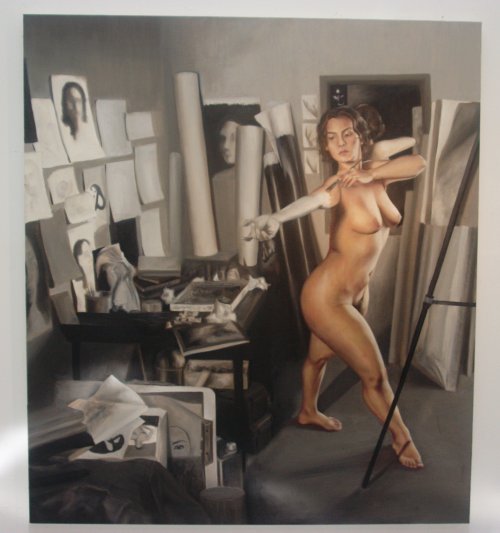
Karina's studio showing one of her unfinished self-portraits, 2007.
Her painting is really something. I would be hypnotized watching her work. Her method is so, well, methodical: She starts by mixing up her colors and putting them into tubes. Then she begins the painting itself by carefully transferring her source -- in this case, photos -- to the canvas using the grid method. She draws in the major outlines, then covers the canvas in a single, dull color approximating Terra Verte. Then she goes in with a rag and subtractively defines all the shapes and shading in the painting. The result is something almost anyone would be willing to end with and declare finished, but Karina can't stop there. After that layer dries, she puts down a grisaille using all her neutrals from black to white. (She has a glass palette with the Munsell scale under it for value matching.) Once that layer dries, she goes back in with thin transparent color glazes.
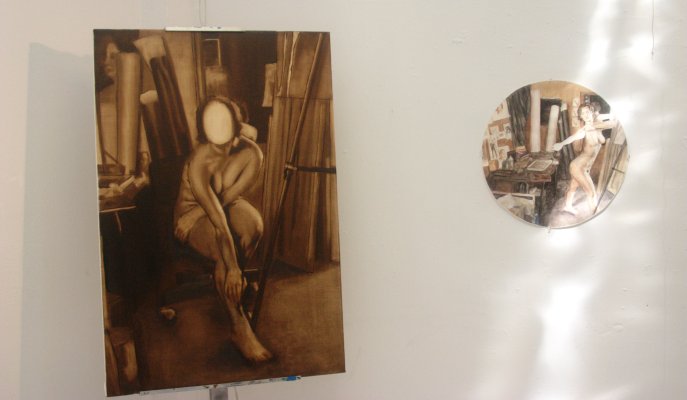
Karina's studio showing another one of her unfinished self-portraits and the watercolor study for the first one, 2007.
It's an old reliable method -- Caravaggio painted this way -- and it suits her well. It relies on having strong drawing skills, which Karina definitely has. She's got a steady hand and a very deft touch with the brush; watching her there were times I could barely see the paint she was putting down.
In fact watching her made me jealous; she made me think I should go back to painting that way, using her as a guide for improving my method. I'd given up painting realistically, but Karina made me think I should try it again. She really made it look easy, if painstaking. (The instructors, some of whom had failed to get Karina to change her direction during the regular school year, warned me away from following her example.)
One of the other great things about Karina was that, because she liked to draw and was good at it, she was in charge of getting in a live model once a week for us to work from. These three sessions (I missed one) were the absolute highlight of my studio time and led to many of the paintings I worked on for the month I was there. The very first life drawing session, in fact, is one of the high points of my artistic life so far.
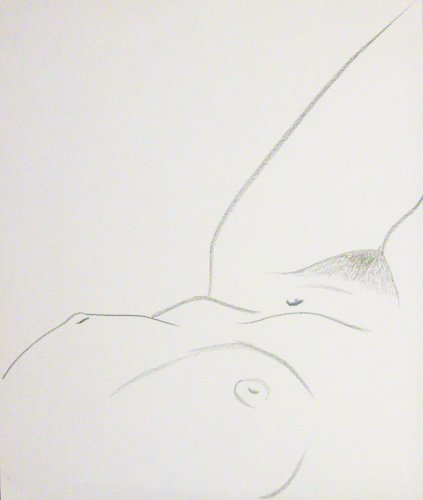
The sketch of Satu I pinned to my wall right after the session.
The very first model was Satu. Now, as artists, we're supposed to say that there's no eros involved in life drawing sessions. We're supposed to be dispassionate observers of form, contour, and shading. It doesn't matter, we say, whether it's a bowl of fruit or plaster Platonic solids or a nude person; we are artists, and we are above all that. Well, I for one have grown tired of that crap. For me, I now believe and am willing to state, eros is not only present, it is to some extent necessary so I can do my best work. I need to be turned on at least a little bit for it to be art. That's probably why I don't paint bowls of fruit or plaster Platonic solids or trees or waterfalls or horses: Because they don't turn me on. They don't even interest me.
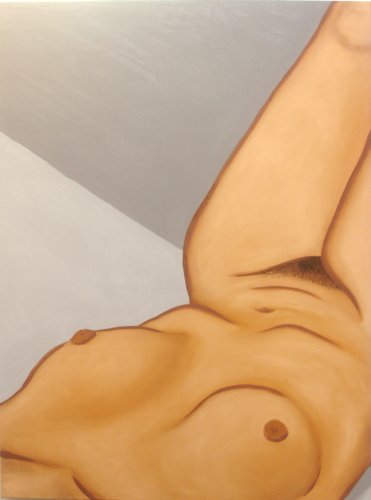
Satu 1, 2007, oil on panel, 30x40 inches.
I am able to say this -- to admit to this -- because of Satu. Because as I turned the corner into Karina's studio I saw Satu posing nude and I immediately fell in love with her. And I turned out some really excellent drawings. I connected with her in a way I didn't connect with the model at the last drawing session I attended; I can't explain what was different this time except for the model.
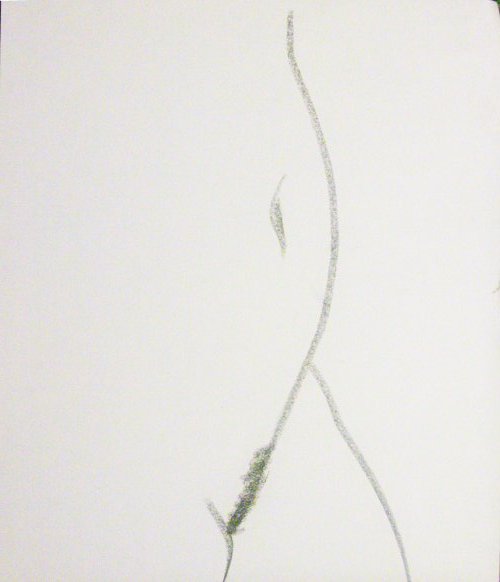
Another sketch of Satu.
Because I can't look at the model as an object. I see the model as a person, a human being who is doing a difficult job; and more, doing a difficult job just to help me, the artist, and the cause of art. Because art modeling certainly doesn't pay that well. Models open up to their artists to some degree; they reveal things they wouldn't ordinarily reveal; they put themselves in the artist's hands.
Since the model is a person, and not just an object, I want to feel some kind of connection to them. I want to know their name, and what they do, and how they like doing what they're doing. I show them the drawings I've made because I figure they must be curious. I offer to give them one or two because I feel they deserve them -- they've worked hard for them.
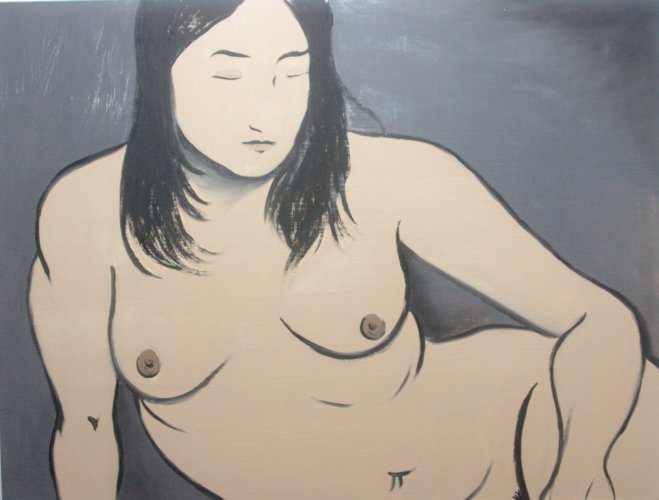
Satu 2, 2007, oil on panel, 30x40 inches.
And Satu, well, she was staggeringly beautiful. When I got back to my studio I immediately hung up the one drawing I liked best; shortly after that, Jerry Saltz and Steve DeFrank dropped by. Jerry said I'm a visionary -- a visionary -- and Steve pretty much agreed.
I was high for two days.
Later I decided to take down whatever drawings I thought were weak and put up the new ones; I ended up taking down all of my drawings and putting up the drawings from my time with Satu. And when I started a new painting, it was from one of those drawings. For a little while, my studio was a shrine to Satu. It was fantastic.
For the next model session I would be attending, I requested a male model. Ike showed up. When Ike took off his robe, I nearly shouted "HOLY CRAP!" If that's what males look like, then I'm some third gender no one's named yet. Let me take this moment to christen it: Hork. I'm not male or female, I'm hork.
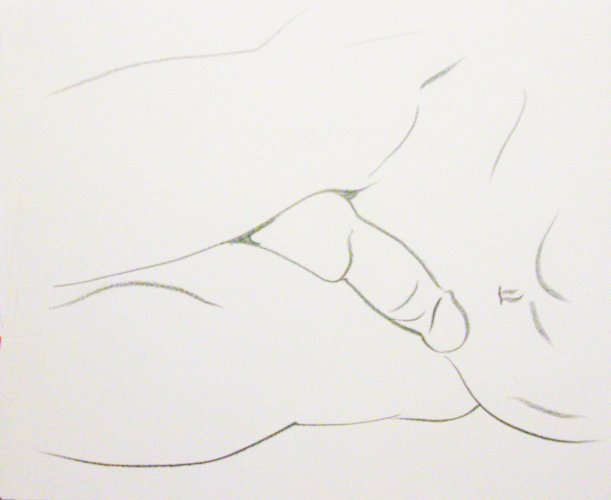
Here's one kind of focused sketch of Ike.
Again, there was eros. I'm fairly straight, but damn if there wasn't something about Ike. There was that connection. Male nudes are often described as "homoerotic" but I think that's unfair -- they're just plain erotic, no homo necessary. Any nude includes some amount of sexual energy, not because nudity is itself sexy, but because when you see people nude, you're seeing them as whole beings, including the parts they use for sex.
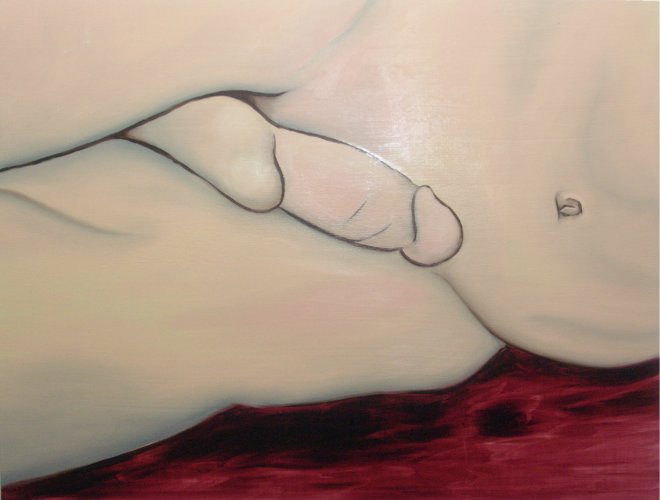
Ike 1, 2007, oil on panel, 30x40 inches.
Ike ended up in one painting I like very much. I'll admit that partly I like it because it shows I'm not all about women and tits and ass and pussies: Cocks are welcome too! But I also like it as a painting in its own right.
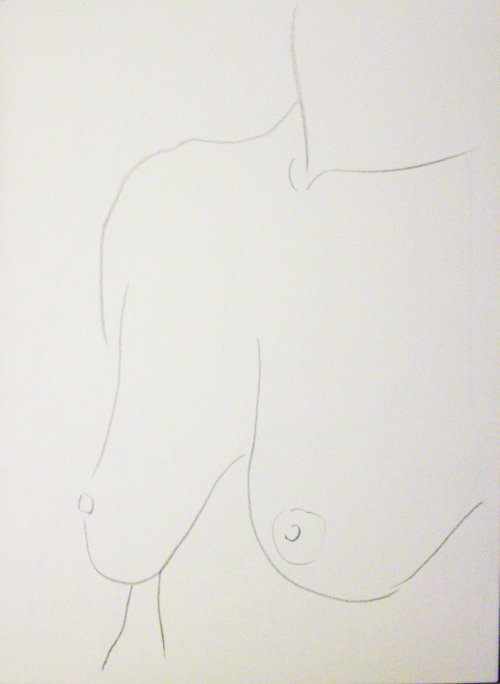
This is a drawing I did of Monica.
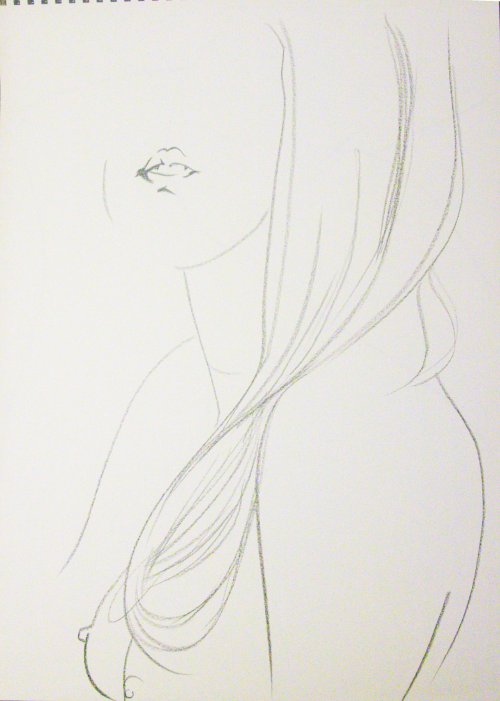
And here's one with her hair which I liked so much.
The final model was Monica. I didn't connect with her quite as strongly as the others but still got some good drawings out of the session; she was wonderfully brown-skinned and beautiful, with a fall of long brown hair Karina and I enjoyed sketching immensely. I ended up filling one whole pad, all fifty sheets, with drawings of her. I think she'll end up in a painting or two eventually. Curiously, Monica was the most comfortable with being nude: Neither Ike nor Satu were very talkative during their sessions but Monica happily carried on conversations while she was dressing or undressing, dressed or undressed, and didn't really seem to notice a difference from one to the other.
I'll continue with the other artists I met next time I get a chance. For now, I'm off to Florida with the family.


a. I loved hearing about how Karina works. She has almost the EXACT process as I do, but with entirely different results. Ain't art great?b. Your figure drawings are really nice and I can see that you felt a connection with your models. But it is also a very good sign that the drawings you did from a model that you didn't have such a connection with, are beautiful as well. c. It is nice to see a penis painting from you, and the drawing and painting you've posted are quite nice, if a bit um, close.d. I am devastated that you have so many new girlfriends. I guess I am an ex-girlfriend now. I can't compete and I don't do harems:)I am so glad this was a great experience for you, Chris.
Hey Chris it seems like this was a great experience for you. I think your drawing git so much better.The Caravaggio painted this way thing is something I have to take issue with. We don't really know how he painted exactly he was a wiz. I mean there is the under painting but Munsell was not even around then. I know I am being a bit picky but the way Karina is painting is more like Frank Rielly than Caravaggio. I use Munsell a bit myself I have his book, it's very good book to use to learn about hue, chroma and value. I use gray scales as well, not only for under painting, but to help control the color hue, chroma, and values. Karina's work looks very interesting I want to see more.
I wanted so badly to do some academic realist-style drawings from life, PDog, just to show you I could. But when it came right down to it, I realized my hands weren't interested. I don't know why, but I'm not excited by shading.And of course you'd take issue with my characterization of Caravaggio. But I got it from Joseph Sheppard, who got it from people who've really studied Caravaggio's work. Sure, we'll never know for sure how he worked (although he certainly didn't use the Munsell scale) but we do have a pretty good idea.Karina's work is really great and I wish there was more to see. But she doesn't seem to have made photos available yet.
Oh, and Tracy: I'm afraid it's too late; you're already part of my harem.
Horks shall inherit the earth.
NIce Satu 2 and both Ikes (drawing and painting)Nice to see the richness.
When is part 2 going up? Inquiring minds want to know.....Sincerely,Ling and Michael, SVA extraordinaires
I'm working on it, I'm working on it.